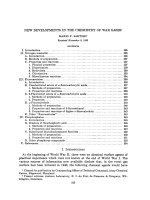New Developments in Agricultural and Industrial Plant Biotechnology
Bạn đang xem bản rút gọn của tài liệu. Xem và tải ngay bản đầy đủ của tài liệu tại đây (341.1 KB, 11 trang )
Chapter 6
New Developments in Agricultural
and Industrial Plant Biotechnology
Ara Kirakosyan, Peter B. Kaufman, and Leland J. Cseke
Abstract New developments in agricultural and industrial plant biotechnology are
quite noteworthy and deserve special mention in this chapter.
In the agricultural sector, we have witnessed the advent of no tillage farming;
significant increases in the use of organic farming practices, including a decrease in
the use of toxic insecticides and herbicides; a quantum leap forward in the spread
of farmers’ markets and sale of locally grown food crops and products; an increase
in the use of seeds of heirloom cultivars of crop plants; an increase in crop species
diversity; an increase in the use of genetically modified food plants in America; a
slowly emerging trend toward urban agriculture; and increasing use of hydroponic
production systems to grow crops year-round in greenhouses.
In the industrial sector, we observe the advent of many new industrial-type prod-
ucts that are derived from plants. These include biodegradable plant-derived plas-
tics, paints and varnishes, adhesives, auto biofuels, de-icers, cleaners, vegetable oils,
essential oils, industrial solvents, pharmaceutical and industrial proteins; soy-based
inks; soy-based spray foam insulation; soy-based carpet backing and padding; and
soy-based wood-like composites used for floors, paneling, and table/countertops.
In this chapter, we present selected examples from each of these topics.
6.1 The Implementation of Organic Farming Practices:
The Reasons, Benefits, and Disadvantages
Organic farming refers to the use of sustainable, environmentally safe practices in
the growing of food crops for humans and domesticated animals. Organic farming
is a form of agriculture which excludes the use of synthetic fertilizers and pesti-
cides, plant growth regulators, livestock feed additives, and genetically modified
(GM) organisms. As far as possible, organic farmers rely on crop rotation, green
manure, compost, biological pest control, and mechanical cultivation to maintain
A. Kirakosyan (
B
)
University of Michigan, Ann Arbor, MI 48109-0646, USA
e-mail:
107
A. Kirakosyan, P.B. Kaufman, Recent Advances in Plant Biotechnology,
DOI 10.1007/978-1-4419-0194-1_6,
C
Springer Science+Business Media, LLC 2009
108 A. Kirakosyan et al.
soil productivity and control pests. Organic farming is often contrasted with con-
ventional, or mainstream, farming (Adeyemi, 2000). Advantages include high con-
sumer acceptance of organically grown products and willingness to pay a higher
price for such food items; enhanced soil fertility and water-holding capacity, espe-
cially long term; gradual purging of the soil of toxic pesticides that may have been
used previously after several years of instituting organic farming practices; organic
certification of the grower as a certified organic farmer once organic standards have
been met; enhanced value of the farmer’s land once it has qualified for organic
certification; fewer health-related problems for the organic grower because of the
practices he/she uses; lower incidence of crop insect pests because of increased
incidence of insect predators. Disadvantages include higher production costs and
greater problems with weeds; hence lower yields over the short term. Reasons for
implementation of organic farming practices include (1) consumer demand; (2)
loss of soil fertility; (3) health problems for the conventional/corporate farmer who
is exposed to a multitude of toxic chemical pesticides – herbicides, insecticides,
fungicides, nematicides, and fumigants; (4) increased profits for the farmer/grower
who grows certified organic crops; and (5) improved adherence to soil conservation
practices.
Regarding GM crops (see Chapter 13), the absolutist position taken by organic
farming adherents against any use of GM crops is currently meeting immense oppo-
sition worldwide from crop biotechnology proponents. The center of the contro-
versy lies in European Union (EU) countries. The latest test comes in the following:
The Public Research and Regulation Initiative (PRRI), a worldwide effort of public
sector scientists involved in research and development of biotechnology for the pub-
lic good, have sent an open letter to the members of the European Commission to
aid them in their orientation discussion on biotechnology. PRRI has expressed deep
concern about the effects of the political situation in Europe affecting genetically
modified (GM) foods and crops.
The initiative notes, that despite clear EU rules and The European Food Safety
Authority (EFSA) conclusions of GMOs not having adverse effect on human and
animal health or the environment, EFSA opinions continue to be ignored. As a result
of this situation, detrimental impacts have been felt both inside and outside the EU,
particularly in developing countries.
Plant pathologist, Pamela Ronald, from the University of California at Davis,
CA, believes that a combination of the two approaches – implementation of organic
farming protocols and inclusion of GM crops – will be important for the future of
global food production. Her view is that genetically modified seeds, when grown
by the use of organic agricultural methods, can significantly increase yields, and
at the same time, reduce the use of environmentally damaging chemicals. This
hypothesis is not dissimilar from the conclusion of the recently published IAASTD
(International Assessment of Agricultural Knowledge, Science and Technology for
Development) report. This 2-year intergovernmental project is designed to
investigate the role that agricultural science, knowledge, and technology can play
in world poverty. The report concludes that a complete agricultural revolution is
needed where agriculture is no longer thought of as production alone.
6 Agricultural and Industrial Plant Biotechnology 109
6.2 Recent Achievements in Improving Crop Diversity: What
Are the Driving Forces in Play Here?
As of 2003, in the United States, there were only 20 major agricultural products
(these are listed in a table along with amounts produced) in commercial production
(Table 6.1).
The only other crops to ever appear in the top 20 in the last 40 years were, com-
monly, tobacco, barley, and oats, and, rarely peanuts, almonds, and sunflower seeds
(in all, only 26 of the 188 crops the FAO tracks worldwide). Both alfalfa and hay
would be in the top 10 in 2003 if they were tracked by FAO.
This has resulted in a major loss in agricultural product diversity as compared
with that which existed in the 1800s. For example, concerning vegetable crop diver-
sity, according to the Rural Advancement Foundation (now called ETC Group),
75 types of vegetables, or approximately 97% of the varieties available in 1900,
are now extinct (Kimbrell, 2002). Accompanying this decrease in crop diversity of
vegetable and most other types of crops is the trend for small farms to disappear and
for existing farms to become much larger.
What are the attributes of this trend? Corporate agribusiness is the current model
and has ended up controlling farming practices. Linked to this is the fact that
monocultures have become most common. Furthermore, chemical agriculture is the
primary system in use. As a result, we have increased production costs. Fewer peo-
ple are engaged in farming. There is an increase in the incidence of crop pests. And,
there is a reduction in quality of the crop products produced. As a consequence of
these events, we might ask, is there any trend toward outsourcing crops from the
Table 6.1 The top 20
agricultural products of the
United States by value as
reported by the Food and
Agricultural Organization of
the United Nations (FAO) in
2003 (Products are ranked by
their mass, multiplied by the
1999–2001 international
prices. Mass is in metric
tonnes.)
Agricultural products Mass (tonnes)
1.
Corn 256,904,992
2.
Cattle meat 11,736,300
3.
Cow’s,milk,whole,fresh 78,155,000
4.
Chicken meat 15,006,000
5.
Soybeans 65,795,300
6.
Pig meat 8,574,290
7.
Wheat 63,589,820
8.
Cotton lint 3,967,810
9.
Hen eggs 5,141,000
10.
Turkey meat 2,584,200
11.
Tomatoes 12,275,000
12.
Potatoes 20,821,930
13.
Grapes 6,125,670
14.
Oranges 10,473,450
15.
Rice, paddy 9,033,610
16.
Apples 4,241,810
17.
Sorghum 10,445,900
18.
Lettuce 4,490,000
19.
Cottonseed 6,072,690
20.
Sugar beets 27,764,390
110 A. Kirakosyan et al.
United States to other countries? No, this is really not the case because we are sim-
ply now using more of crops, such as banana, papaya, mango, star fruit, and kiwi,
that are only grown in other countries.
With the advent of organic agriculture (see above), and because of consumer
demand, we are now witnessing a steady increase in crop diversity on American
farms. Consumers are demanding more nutritious products and foods that are health-
ier for them. This is driven, in part, by a parallel increase in the use of integrative
medicine and preventive medicine in our health system.
What are some of the less common edible crops, not included in the top
20 major crop species that account for this increase in crop diversity? They
include teff (Eragrostis tef (Zucc.) Trotter), quinoa (Chenopodium quinoa Willd.),
grain amaranth (Amaranthus cruentus L.), wild rice (Zizania aquatica L.),
canola/rapeseed (Brassica napus L.), sunflowers (Helianthus annuus L.), giant
pumpkins (Cucurbita pepo L.), culinary herbs, heirloom vegetables (see Seeds of
Change, www.seedsofchange.com), cassava, taro, kiwi, and many edible fruits that
include new cultivars of grapes (Vitis spp. L.), blueberries, (Vaccinium spp. L.),
sour cherries (Prunus cerasus L.), Goji berry/wolfberry (Lycium barbatum Thunb.),
elderberry (Sambucus canadensis L.), thornless blackberries (Rubus canadensis L.),
Cornelian cherry (Cornus mas L), chokeberry (Aronia arbutifolia (L.) Pers. and
A. melanocarpa (Michx.) Elliott), and hawthorn (Crataegus laevigata (Poir.) DC.
and C. monogyna Jacq.). Reasons why a wide spectrum of colored fruits and veg-
etables, like many of the above, are desirable for significantly improved health are
described in “The Color Code: A Revolutionary Eating Plan for Optimum Health”
by Joseph et al. (2002).
6.3 The Rise of Urban Agriculture
Grow gardens refer to collections of vegetables and flowers that are grown in rela-
tively small plots in urban environments. The increasing presence of grow gardens
in many cities in the United States, Europe, and Asia is one of the hallmarks of urban
agriculture at work. The impetus for this activity is to satisfy the need to obtain our
food locally rather than via world commerce, to save energy, to lower production
costs, to improve human health, and to obtain fresher produce. Grow gardens allow
urbanites to know where their food comes from, to be able to grow food crops
without the use of toxic pesticides, to learn how it is grown and harvested, to
get good exercise (and thus, to help fight a growing problem of obesity), to pro-
vide a greater diversity of foods in the diet, to promote human interactions, and to
reduce urban crime. Grow gardens have also helped to restore the work ethic among
urbanites. One other spin-off is that urban crops sequester carbon dioxide, and thus,
help to reduce global warming. They also mitigate high summer temperatures via
evaporative cooling from leaves of the crops grown (via the process of transpiration
or water evapo-transpiration from the leaves).
Many grow gardens are now being developed as “rooftop gardens” where grow-
ing space is limited. They are also being located at ground level near churches and
6 Agricultural and Industrial Plant Biotechnology 111
schools, in parks, botanical gardens, and arboreta, and in lots where old houses and
commercial buildings have been removed. It is essential that they should not be
located in brown fields where the soil is contaminated with toxic residual chemicals
and waste products.
6.4 The Use of Hydroponics Techniques for Commercial Food
Production
Hydroponics refers to the cultivation of plants in complete nutrient solutions in the
absence of soil. The first crops to be commercially grown with hydroponics included
tomatoes and peppers, but the techniques were soon successfully extended to other
crops such as lettuce, cucumbers, many kinds of culinary herbs, and cut flowers
(Sustainable Living Articles at ; Mason, 2000). Val-
ued at 2.4 billion dollars the hydroponic greenhouse vegetable industry has a growth
rate of 10% per year and accounts for nearly 95% of the greenhouse vegetables
produced in North America.
What are the advantages of hydroponics? Hydroponics, when used in green-
houses, allows for the cultivation of plants throughout the year. Other advantages
include nutritious, healthy, and clean produce; improved and consistent quality of
produce; and elimination of the use of toxic pesticides and herbicides. Notable, also,
is the fact that specialty crops like culinary herbs, or even the above-mentioned veg-
etable crops or florist crops, can be grown hydroponically in gutter troughs in 42-day
turn-around cycles (date of seed planting in biodegradable foam plugs to date of har-
vest) for most annual culinary herbs in greenhouses. The greenhouses can be heated
from natural gas (methane) derived from garbage-filled landfills or from geother-
mal systems and illuminated continuously with full spectrum lamps with electricity
generated by photovoltaic panels or wind generators.
Are there any disadvantages attributed to hydroponics? One entails high start-up
costs. Another is that the whole process is highly labor-intensive as compared with
field crop production, which, because of it being highly mechanized, involves much
less hand labor.
What about yield comparisons? Commercial hydroponics systems have proven
to be more productive than conventional systems of agriculture. Most commer-
cial hydroponics greenhouse facilities are built sufficiently large to take advan-
tage of economies of scale. Typically, these cover areas more than 10 acres, while
smaller ones measure around 2 acres. In commercial practice, the yield of hydro-
ponically grown tomatoes can be more than double that of soil-based systems due
to the reduced turnover time between crops, better nutrition, and crop management.
The dramatic increase in yields with hydroponics is best illustrated if we consider
the actual production figures of soil-grown and hydroponically grown produce. Field
grown tomatoes average yields ranging between 40,000 and 60,000 pounds per
acre; on the other hand top growing hydroponics facilities in the United States and
Canada report average yields of more than 650,000 pounds of tomatoes per acre.









